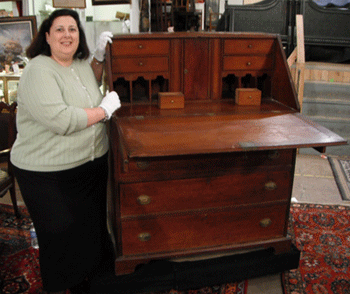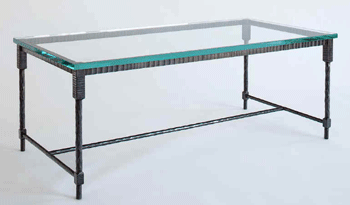|

|
Art & Antiques by Dr. Lori
Appraising Thomas Jefferson’s Desk and Other Hepplewhite Furniture
|
By Lori Verderame
Posted July 2013
During a recent episode of Discovery Channel’s TV show Auction Kings, I appraised a Federal Period writing desk that was once owned by President Thomas Jefferson at his country estate of Poplar Forest. I described the desk as Hepplewhite in style relating to the designs of the British cabinetmaker, George Hepplewhite. Like President Jefferson, many of us currently own examples of Hepplewhite furniture today, both original and reproductions. In its day, Hepplewhite was often referred to as “city furniture.”
George Hepplewhite (died 1768) was a London designer and cabinetmaker. His famous guidebook, The Cabinet Maker and Upholsterers Guide was published in 1788 after his death. The guidebook sparked a period of popularity for the furniture designs known as Hepplewhite style from 1780 to 1810. Hepplewhite furniture was especially popular in American states from New England to the Carolinas during the Federal Period.
|

|
Dr. Lori on the set of Discovery’s Auction Kings with President Thomas Jefferson’s Hepplewhite slant-top writing desk. (Photo: staff of www.DrLoriV.com)
|
One of the most popular pieces in the Hepplewhite style is the dining room sideboard or buffet. In the early 1800s, a sideboard was a new furniture form. Hepplewhite sideboards are often bow-shaped, Bombay-shaped, or serpentine (curved). In the late Victorian Period, circa 1870s-‘80s, Hepplewhite reproductions came to the market.
Some of the distinguishing traits of true Hepplewhite furniture include a consistency of formal design. Hepplewhite pieces typically have straight legs which may be square or tapered at the bottom (or at the foot). An H-stretcher is common on Hepplewhite chairs and sofas. What’s an H-stretcher? It is a reinforcing piece of wood that connects the legs of a chair or sofa to form the shape of the letter H.
|

|
An example of an H-stretcher support for a side table.
|
The Hepplewhite-style feet are simply styled and straightforward. They may be a rectangular spade foot (like the garden tool) or in the shape of an arrow (as if the arrow is shot directly down into the ground) at the bottom of the leg of a chair or sofa. On heavier pieces of furniture like a desk, chest or tall case, bracketed feet are common.
One of the most characteristic traits of Hepplewhite furniture is the use of intricate inlays of contrasting woods and burl veneers. Hepplewhite pieces may be made of sycamore veneers, birch or rosewood. Satinwood, maple and mahogany are also standard woods that are found on Hepplewhite furniture. Decorative motifs include urns, feathers, geometric shapes, shields, ribbons, swags and leaves.
Many manufacturers reproduced Hepplewhite-style furniture in the 1900s following in the formal footsteps of the Federal style. Today, Hepplewhite furniture commands high values at auction for its classical lines and formal look. A reproduction Hepplewhite sideboard can command a few thousand dollars on the open market, whereas a good, original example of Hepplewhite furniture can bring $50,000-$75,000 at auction.
Celebrity Ph.D. antiques appraiser, author, and award-winning TV personality, Dr. Lori hosts antiques appraisal events worldwide. Dr. Lori is the star appraiser on Discovery channel’s Auction Kings. To learn about your antiques, visit www.DrLoriV.com, www.Facebook.com/DoctorLori, @DrLori on Twitter
or Lori Verderame on Google+.
|